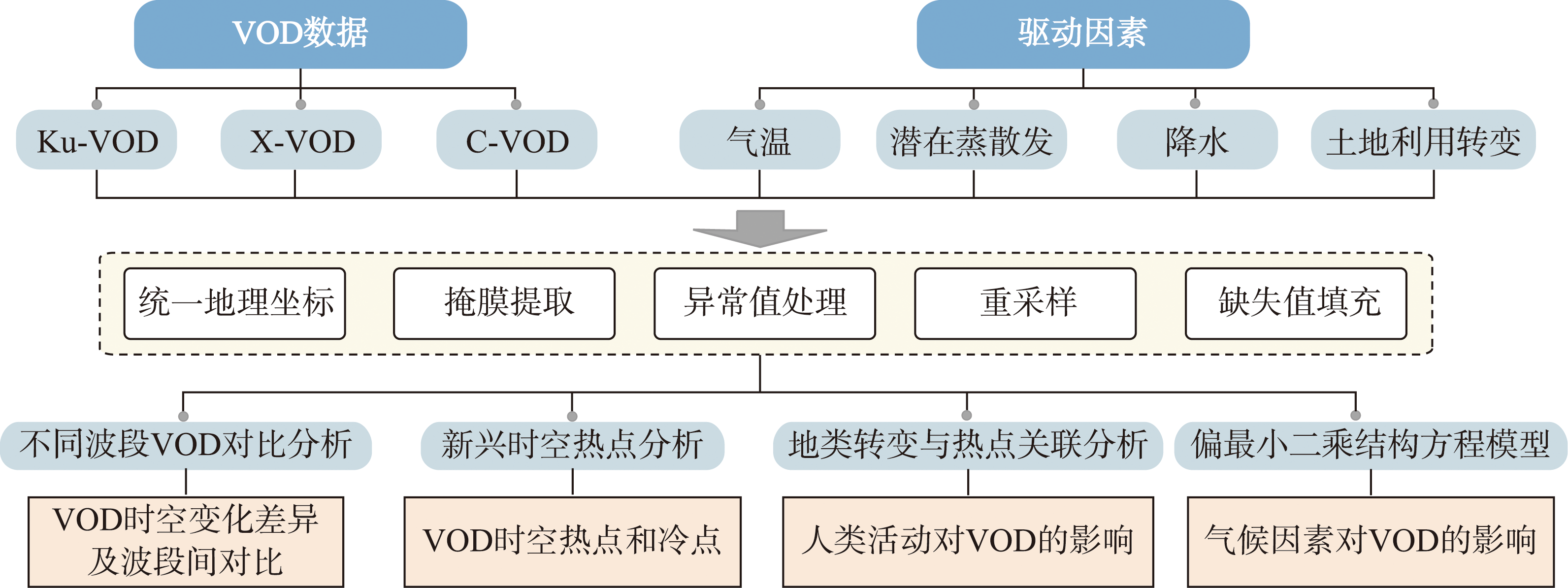

Spatio-temporal patterns of vegetation optical depth and its influencing factors over China
Received date: 2023-10-31
Revised date: 2025-04-15
Online published: 2025-05-23
This study utilizes emerging hotspot analysis to explore the spatio-temporal trends of vegetation optical depth (VOD) observed in Ku, X, and C microwave bands over China from 2002 to 2017. Furthermore, it analyzes the impacts of anthropogenic activities, represented by land use change, on the spatial and temporal changes in VOD, and employs Partial Least Squares Structural Equation Model to quantitatively assess the climatic effects on VOD changes. Overall, VOD exhibits a southeast-to-northwest gradient over China, with central and southern regions identified as VOD hotspots, while Xinjiang and the central Inner Mongolia Plateau are identified as VOD cold spots. Regions with consistent emerging hotspot analysis results across the three bands demonstrate a "greening" phenomenon in sparsely-vegetated regions nationwide. Additionally, the association between land use change and emerging hotspots reveals strong impacts of human activities on VOD variations. Specifically, persistent and intensified VOD hotspots predominantly correspond to scenarios where grassland is converted to forest. Attribution of VOD changes using Partial Least Squares Structural Equation Modeling indicates that, in the humid zone, where hydrothermal conditions are favorable and soil moisture is abundant, further increases in temperature and precipitation may inhibit vegetation growth. In contrast, in the arid zone, the inhibitory effect of temperature is less prominent. In the Tibetan Plateau, increases in both temperature and precipitation will promote vegetation growth. The insights from this study are expected to provide scientific support for monitoring ecosystem changes, uncovering their driving forces, and assessing the effectiveness of ecological measures.

SHI Manqing , YANG Xiaoyu , QIU Jianxiu , LUO Ming , WANG Qianfeng , WANG Dagang . Spatio-temporal patterns of vegetation optical depth and its influencing factors over China[J]. Acta Geographica Sinica, 2025 , 80(5) : 1212 -1225 . DOI: 10.11821/dlxb202505004
| [1] |
[赵静, 李静, 穆西晗, 等. 高分一号卫星中国植被覆盖度高时空分辨率产品验证与分析. 遥感学报, 2023, 27(3): 689-699.]
|
| [2] |
|
| [3] |
|
| [4] |
|
| [5] |
|
| [6] |
|
| [7] |
[金凯, 王飞, 韩剑桥, 等. 1982—2015年中国气候变化和人类活动对植被NDVI变化的影响. 地理学报, 2020, 75(5): 961-974.]
|
| [8] |
[刘悦, 刘欢欢, 陈印, 等. 2000—2018年中国植被光学厚度时空动态特征及驱动因素. 地理学报, 2023, 78(3): 729-745.]
|
| [9] |
[王琦, 柴琳娜, 赵少杰, 等. 基于多角度微波辐射亮温数据反演冬小麦光学厚度. 遥感技术与应用, 2015, 30(3): 424-430.]
|
| [10] |
|
| [11] |
|
| [12] |
|
| [13] |
|
| [14] |
|
| [15] |
|
| [16] |
|
| [17] |
|
| [18] |
|
| [19] |
|
| [20] |
|
| [21] |
[杨绪红, 金晓斌, 杨永可, 等. 1950—2020年东北地区林地时空变化特征分析. 地理科学, 2022, 42(11): 1996-2005.]
|
| [22] |
[白昆立, 陈蕾伊, 邓洪涛, 等. 华南地区不同类型森林生态系统植被碳现状研究. 林业与环境科学, 2022, 38(6): 102-108.]
|
| [23] |
[朱军强. 国家退牧还草工程出台新政策. 中国产业, 2011(10): 18-19.]
|
| [24] |
|
| [25] |
|
| [26] |
[李茂华, 都金康, 李皖彤, 等. 1982—2015年全球植被变化及其与温度和降水的关系. 地理科学, 2020, 40(5): 823-832.]
|
| [27] |
[莫兴国, 刘苏峡, 胡实. 黄河源区气候—植被—水文协同演变及成因辨析. 地理学报, 2022, 77(7): 1730-1744.]
|
| [28] |
|
| [29] |
|
| [30] |
|
| [31] |
|
| [32] |
|
| [33] |
|
| [34] |
|
| [35] |
|
| [36] |
[杨天垚, 邱建秀, 肖国安. 华北农业干旱监测与冬小麦估产研究. 生态学报, 2023, 43(5): 1936-1947.]
|
| [37] |
|
/
| 〈 |
|
〉 |